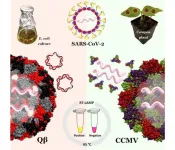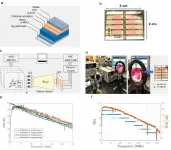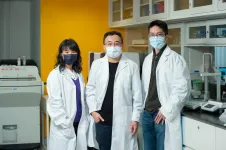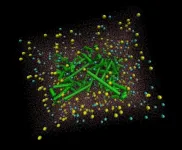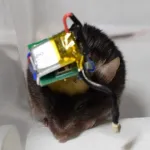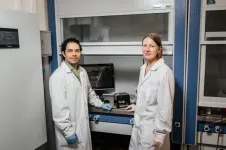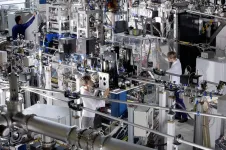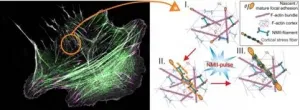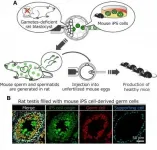(Press-News.org) Rapid COVID-19 tests are on the rise to deliver results faster to more people, and scientists need an easy, foolproof way to know that these tests work correctly and the results can be trusted. Nanoparticles that pass detection as the novel coronavirus could be just the ticket.
Such coronavirus-like nanoparticles, developed by nanoengineers at the University of California San Diego, would serve as something called a positive control for COVID-19 tests. Positive controls are samples that always test positive. They are run and analyzed right alongside patient samples to verify that COVID-19 tests are working consistently and as intended.
The positive controls developed at UC San Diego offer several advantages over the ones currently used in COVID-19 testing: they do not need to be kept cold; they are easy to manufacture; they can be included in the entire testing process from start to finish, just like a patient sample; and because they are not actual virus samples from COVID-19 patients, they do not pose a risk of infection to the people running the tests.
Researchers led by Nicole Steinmetz, a professor of nanoengineering at UC San Diego, published their work in the journal Biomacromolecules.
This work builds on an earlier version of the positive controls that Steinmetz's lab developed for the RT-PCR test, which is the gold standard for COVID-19 testing. The positive controls in the new study can be used not only for the RT-PCR test, but also for a cheaper, simpler and faster test called the RT-LAMP test, which can be done on the spot and provide results in about an hour.
Having a hardy tool to ensure these tests are running accurately--especially for low-tech diagnostic assays like the RT-LAMP--is critical, Steinmetz said. It could help enable rapid, mass testing of COVID-19 in low-resource, underserved areas and other places that do not have access to sophisticated testing equipment, specialized reagents and trained professionals.
Upgraded positive controls
The new positive controls are essentially tiny virus shells--made of either plant virus or bacteriophage--that house segments of coronavirus RNA inside. The RNA segments include binding sites for both of the primers used in the PCR and LAMP tests.
"This design creates an all-in-one control that can be used for either one of these assays, making it very versatile," said first author Soo Khim Chan, who is a postdoctoral researcher in Steinmetz's lab.
The team developed two types of positive controls. One was made from plant virus nanoparticles. To make them, the researchers infected cowpea plants in the lab with cowpea chlorotic mottle virus and then extracted the viruses from the plants. Afterwards, the researchers removed the virus' RNA and replaced it with a custom-made RNA template containing specific yet non-infectious sequences from the SARS-CoV-2 virus. The resulting nanoparticles consist of coronavirus RNA sequences packaged inside plant virus shells.
The other positive control was made from bacteriophage nanoparticles. It involved a similar recipe. The researchers infected E. coli bacteria with custom-made plasmids--rings of DNA--that contain specific fragments of sequences (which are also non-infectious) from the SARS-CoV-2 virus, as well as genes coding for surface proteins of a bacteriophage called Qbeta. This process caused the bacteria to produce nanoparticles that consist of coronavirus RNA sequences packaged inside bacteriophage shells.
The plant virus and bacteriophage shells are key to making these positive controls so sturdy. They protect the coronavirus RNA segments from breaking down at warmer temperatures--tests showed that they can be stored for a week at temperatures up to 40 C (104 F). The shells also protect the RNA during the first step of the PCR and LAMP tests, which involves breaking down cells in the sample--via enzymes or heat--to release their genetic material for testing.
These protections are not present in the positive controls currently used in COVID-19 testing (naked synthetic RNAs, plasmids or RNA samples from infected patients). That's why existing controls either require refrigeration (which makes them inconvenient to handle, costly to ship and store) or have to be added at a later stage of the test (which means that means scientists will not know if something went wrong in the first steps).
As a next step, the researchers are looking to partner up with industry to implement this technology. The positive controls can be adapted to any established RT-PCR or RT-LAMP assay, and using them would help negate false readouts, Steinmetz's team said. Plus, these positive controls can be easily produced in large quantities by molecular farming in plants or microbial culture fermentation, which is good news for translating them to large-scale manufacturing.
"With mutants and variants emerging, continued testing will be imperative to keep the population safe," Steinmetz said. "The new technology could find utility in particular for at-home tests, which may have a higher rate of false readouts due to the less controlled experimental conditions."
INFORMATION:
Paper title: "Virus-Like Particles as Positive Controls for COVID-19 RT-LAMP Diagnostic Assays."
This work was funded in part by the National Science Foundation (RAPID CBET-2032196 and RAPID CMMI-2027668) and the University of California (UCOP-R00RG2471 and a Galvanizing Engineering in Medicine Award).
Around the world there are currently more than 18 billion internet-connected mobile devices. In the next 10 years, anticipated growth in the Internet of Things (IoT) and in machine-type communication in general, will lead to a world of hundreds of billions of data-connected objects. Such growth poses two very challenging problems:
How can we securely connect so many wireless devices to the Internet when the radio-frequency bandwidth has already become very scarce?
How can all these devices be powered?
Regular, manual charging of all mobile Internet-connected devices will not be feasible, and connection to ...
A Hong Kong Baptist University-led (HKBU) research team has developed a novel drug which has the potential to become a next-generation treatment for cancers associated with Epstein-Barr virus (EBV).
The peptide-linked drug, which is responsive to the acidic environment found in tumours, is the first known agent to have successfully targeted two viral proteins that are simultaneously produced by EBV. It also offers a new strategy by increasing the uptake of anti-cancer drugs in tumour cells, thus allowing the application of lower drug dosages which helps reduce treatment side effects and health risks.
The research results were published in the international academic journal Advanced Science.
New drug targets ...
Modern electronics is approaching the limit of its capabilities, which are determined by the fundamental laws of physics. Therefore, the use of classical materials, for example, silicon, is no longer able to meet the requirements for energy efficiency of the devices. Currently, it is necessary to start searching for new materials, new principles of electronic devices' functioning. To solve this problem, researchers of Peter the Great St.Petersburg Polytechnic University (SPbPU) are developing thin films, the elements for biomolecular electronics. Scientists believe that biological macromolecules such as nucleic acids, proteins, amino acids can become a promising material for modern ...
Overview:
A research team at the Department of Electrical and Electronic Information Engineering, Department of Computer Science and Engineering, Department of Applied Chemistry and Life Science, and the Electronics-Inspired Interdisciplinary Research Institute (EIIRIS) at Toyohashi University of Technology has developed a lightweight, compact, Bluetooth-low-energy-based wireless neuronal recording system for use in mice. The wireless system weighs END ...
A number of scientists whose work is inspired by natural behavior is constantly growing. The lotus flower, with its ability to self- clean, is commonly described in literature and can be best examples the trend. Researchers started to wonder why the flower behaves in this manner and they decided to study its structure with the use of microscopes. Hence, they could draw the conclusion that the structure is highly hydrophobic, i.e. it maintains water drops on the surface. Water then collects particles of dust and by flowing down, removes them by flowing down. It means the adhesion forces, those responsible ...
The lists of Earth's endangered animals and plants are getting increasingly longer. But in order to stop this trend, we require more information. It is often difficult to find out exactly where the individual species can be found and how their populations are developing. According to a new overview study published in Methods in Ecology and Evolution by Dr Annegret Grimm-Seyfarth from the Helmholtz Centre for Environmental Research (UFZ) and her colleagues, specially trained detection dogs can be indispensable in such cases. With the help of these dogs, the species sought can usually be found faster and more effectively than with other methods.
How many otters are there ...
TPU researchers jointly with their colleagues from foreign universities have developed a method that allows for a laser-driven integration of metals into polymers to form electrically conductive composites. The research findings are presented in Ultra-Robust Flexible Electronics by Laser-Driven Polymer-Nanomaterials Integration article Ultra-Robust Flexible Electronics by Laser-Driven Polymer-Nanomaterials Integration, published in Advanced Functional Materials academic journal (Q1, IF 16,836).
"Currently developing breakthrough technologies such as the Internet of Things, flexible electronics, brain-computer interfaces will have a great impact on ...
The key are the ultra-fast flashes of light, with which the team led by Dr. Friedrich Roth works at FLASH in Hamburg, the world's first free-electron laser in the X-ray region. "We took advantage of the special properties of this X-ray source and expanded them with time-resolved X-ray photoemission spectroscopy (TR-XPS). This method is based on the external photoelectric effect, for the explanation of which Albert Einstein received the Nobel Prize in Physics in 1921.
"For the first time, we were able to directly analyze the specific charge separation and subsequent processes when light hits a model system such as an organic solar cell. ...
Research groups at the University of Helsinki uncovered how motor protein myosin, which is responsible for contraction of skeletal muscles, functions also in non-muscle cells to build contractile structures at the inner face of the cell membrane. This is the first time when such 'mini-muscles', also known as stress fibers, have been seen to emerge spontaneously through myosin-driven reorganization of the pre-existing actin filament network in cells. Defects in the assembly of these 'mini-muscles' in cells lead to multiple disorders in humans, and in the most severe cases to cancer progression.
A new study published in eLife, drills into the core mechanisms of stress fiber assembly, and reveals how stress fibers can be built directly ...
Okazaki, Japan - Making gametes such as sperm and eggs from pluripotent stem cells, primitive cells that can make all the tissues, greatly contributes to efficient reproduction of livestock animals and future assisted reproductive medicine. Researchers pave the way to achieve this goal using a body of xenogenic animals.
The researchers previously developed a method to grow stem cells into an entire organ in the body, so-called blastocyst complementation. The blastocyst is a structure of early embryos. If stem cells are transplanted into the blastocyst obtained from animals that cannot make a certain organ, ...
